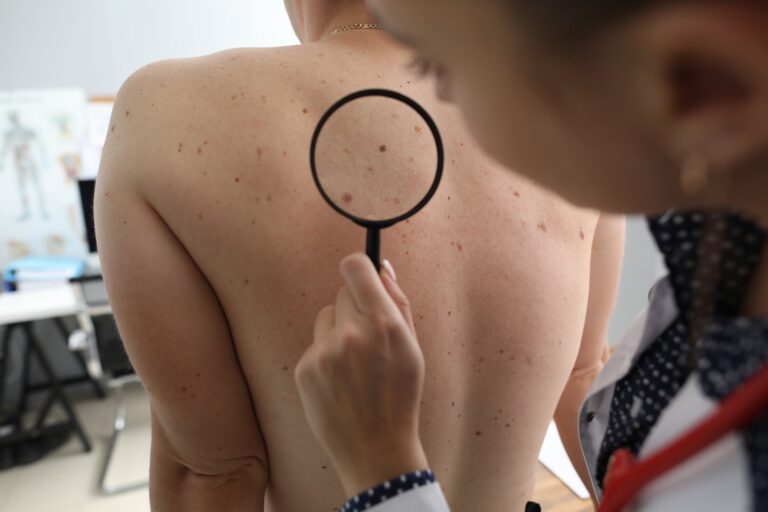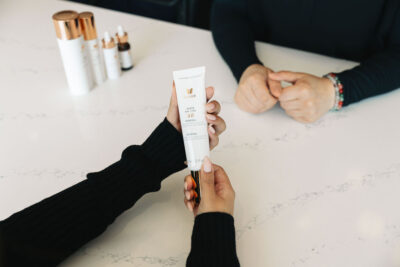October 1, 2024
Moles are common skin growths that usually appear as small, dark spots. Most moles are harmless, but sometimes they can be a sign of skin cancer. It’s important to know how to tell if a mole is dangerous so you can get help if you need it. Early detection can make a big difference in treatment outcomes.
Most people have moles, and they come in different shapes and sizes. Some moles are present at birth, while others develop over time due to sun exposure or genetics. Understanding what a normal mole looks like can help you spot any changes that might be concerning.
Identifying Normal vs. Abnormal Moles
Most moles are small brown or black spots on the skin that are usually round or oval and less than 6 millimetres in diameter. These normal moles have a smooth surface and a clear, even colour. They can appear anywhere on the body and are generally harmless.
Normal Moles:
- Shape and Size: Round or oval, usually small.
- Colour: Even colour, typically brown or black.
- Surface: Smooth and flat or slightly raised.
- Symmetry: Symmetrical, meaning one half looks like the other half.
Abnormal Moles:
Abnormal moles, also known as dysplastic nevi, can look different from normal moles. They may be larger, have an irregular shape, or show multiple colours. These moles are not always cancerous but should be monitored closely.
- Shape and Size: Irregular shape, bigger than a pencil eraser.
- Colour: Uneven colour, with multiple shades of brown, black, red, or even blue.
- Surface: Scaly, crusty, or rough.
- Symmetry: Asymmetrical, meaning the two halves do not match.
Knowing these differences can help you keep an eye on moles that might need further examination. If a mole changes over time or starts to look different from others on your body, it could be a sign of a problem.
Signs That a Mole Might Be Dangerous
Certain signs can help you identify if a mole might be dangerous. The ABCDE rule is a simple guide to follow when checking your moles.
- A for Asymmetry: Draw an imaginary line through the middle of the mole. If the two halves do not match, this is asymmetry and could be a sign of danger.
- B for Border: Look at the edges of the mole. Normal moles have smooth, even borders. Dangerous moles often have irregular, ragged, or blurred edges.
- C for Colour: Check the colour of the mole. Normal moles usually have one uniform colour. Moles with multiple shades or an uneven distribution of colour could be a concern.
- D for Diameter: Measure the mole. Regular moles are usually smaller than 6 millimetres across. Moles larger than this, especially if they keep growing, should be examined.
- E for Evolving: Keep track of any changes in the mole. Moles that change in size, shape, colour, or symptoms (like itching or bleeding) may be dangerous.
If you notice any of these signs, it is essential to monitor the mole closely and consider getting it checked by a dermatologist. Early detection can make it easier to treat and manage any potential issues.
Self-Examination Tips for Monitoring Moles
Regularly checking your skin can help you spot changes in your moles. Follow these self-examination tips to keep an eye on them.
- Use a Mirror: Use a full-length mirror and a hand-held mirror to check hard-to-see areas. Make sure to look at your back, the back of your neck, and behind your ears.
- Check Head to Toe: Start from your scalp and work your way down to your toes. Don’t forget to look between your fingers and toes, as well as the soles of your feet.
- Good Lighting: Perform the examination in a well-lit room so you can see the details of your moles clearly. Natural daylight often works best.
- Document Changes: Keep a record of your moles by taking pictures. This makes it easier to notice any changes over time. Make a note of the size, shape, and colour of each mole.
- Monthly Routine: Aim to check your moles once a month. This routine helps you become familiar with what’s normal for your skin and more easily spot any changes.
When to See a Dermatologist
Knowing when to see a dermatologist can make a big difference in catching skin issues early. Here are some signs that it’s time to book an appointment.
- Changes in Moles: If you notice any signs from the ABCDE rule – asymmetry, border irregularity, colour changes, diameter larger than 6mm, or evolving features – consult a dermatologist.
- New Growths: If you find a new mole or spot that looks different from your other moles, get it checked out. New growths in adults should be examined.
- Symptoms: If a mole starts itching, bleeding, or becomes painful, it’s essential to have a doctor look at it. These symptoms could indicate something more serious.
- Family History: If you have a family history of skin cancer, you may be at higher risk. Regular check-ups can help catch any issues early.
- Annual Check-Up: Even if you don’t notice any changes, it’s a good idea to have an annual skin check-up with a dermatologist. They can examine areas you might miss and provide peace of mind.
Seeing a dermatologist ensures that any potential problems are identified and treated early. Don’t hesitate to book an appointment if you notice any warning signs or changes in your moles.
Knowing how to tell if a mole is dangerous can help you catch skin issues early and get the right care. By learning the differences between normal and abnormal moles and understanding the signs of danger, you can monitor your skin effectively. Regular self-examinations and knowing when to see a dermatologist play a significant role in maintaining your skin health.
For personalized care and expert advice, schedule a consultation with VIDA Dermatology. Our team of experienced dermatologists is here to help you keep your skin healthy and address any concerns you might have. Don’t hesitate to reach out for a mole removal in Edmonton and take the first step towards better skin care!



